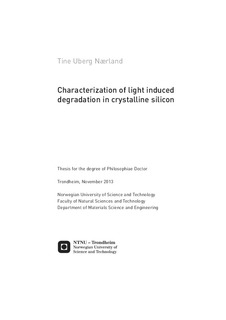| dc.contributor.author | Nærland, Tine Uberg | nb_NO |
| dc.date.accessioned | 2014-12-19T13:27:48Z | |
| dc.date.available | 2014-12-19T13:27:48Z | |
| dc.date.created | 2013-11-28 | nb_NO |
| dc.date.issued | 2013 | nb_NO |
| dc.identifier | 668073 | nb_NO |
| dc.identifier.isbn | 978-82-471-4740-5 (printed ver.) | nb_NO |
| dc.identifier.isbn | 978-82-471-4741-2 (electronic ver.) | nb_NO |
| dc.identifier.uri | http://hdl.handle.net/11250/249426 | |
| dc.description.abstract | Light induced degradation is an unfortunate characteristic of a very commonly used silicon material for solar cells: boron-doped Czochralski silicon. The degradation is attributed to a recombination center that is activated by excess charge carriers, i.e. electrons, and the energy conversion efficiency of the affected cells is severely reduced. The phenomenon has been known since the early 1970's but the fundamental mechanism is still a debated topic. The main focus of this thesis has been to study the role of the excess carrier concentration on the B-O related defect center generation and a new method has been developed to experimentally investigate the relation between the two. Local B-O related defect generation (Spot-LID), where the wafer is exposed to light in a confined area, causes the excess electrons to diffuse out into the wafer, allowing us to study the degradation of a continuously varying electron concentration. This concentration can be monitored by means of photoluminescence (PL) imaging. Through the direct monitoring of the diffused minority carrier density distribution (during light exposure) from an exposed into an unexposed wafer area, compared to the observed defect generation, we were able to monitor the generation of excess carrier induced defects over a range of carrier concentrations. It was verified that the generation of the B-O defect is directly related to the presence of excess minority carriers and that very low concentrations of minority excess carrier densities are sufficient to generate the B-O related defect. Carrier concentrations down to 1.7 ± 0.2 × 109 cm-3 were observed to cause lifetime degradation. We experimentally demonstrated that there exists an excess carrier threshold value, , beyond which the generation rate becomes fully independent of the carrier concentration for the investigated silicon materials ( = 1.84 ± 0.9 × 1011 cm-3). These results indicate that the role of the excess carriers during the rapid decay is to first change the charge state of the defects by shifting the electron quasi-Fermi level across the energy level of the defect center in its passive state (Elat = EV + (635±18) meV) followed by another rate-determining step before the defect center becomes recombination active.
Another topic of this thesis has been to evaluate different ways of measuring the B-O related decay. In this work three different techniques have been employed; Lifetime decay analysis by time-resolved QSSPC, B-O related degradation studied by time-resolved I-V measurements and current induced degradation of in the dark. A part of this work is concerned with the challenges of studying B-O related degradation using a high intensity light source with special attention on the potential increase of the temperature of the sample. For boron-doped Czochralski Cz-Si cells, where an initial decay is occurring during the first minutes, special attention must be given to the temperature rise in the beginning of the measurement in order to differentiate between the reduction in as a result of heating or as a result of B-O related degradation. In the last part of the work a range of silicon wafers were investigated by means of Lifetime decay analysis by time-resolved QSSPC. Curve fitting of the measured data to a single exponential (the solution of a first order rate equation) was attempted but a much better fit was achieved by a solution of a second order rate equation. This indicates that the defect generation process can be better described by second order reaction kinetics and the rate of the reaction is thus changing with the square of the latent defect concentration . The concentration of holes was identified to control the half-life of the degradation process and is either playing a role as a reactant in excess or as a catalyst. | nb_NO |
| dc.language | eng | nb_NO |
| dc.publisher | Norges teknisk-naturvitenskapelige universitet, Fakultet for naturvitenskap og teknologi, Institutt for materialteknologi | nb_NO |
| dc.relation.ispartofseries | Doktoravhandlinger ved NTNU, 1503-8181; 2013: | nb_NO |
| dc.relation.haspart | Nærland, Tine Uberg; Olaisen, Birger Retterstol; Arnberg, Lars. Studying light soaking of solar cells by the use of solar simulator. GETTERING AND DEFECT ENGINEERING IN SEMICONDUCTOR TECHNOLOGY XIV: 435-440, 2011. <a href='http://dx.doi.org/10.4028/www.scientific.net/SSP.178-179.435'>10.4028/www.scientific.net/SSP.178-179.435</a>. | nb_NO |
| dc.relation.haspart | Nærland, Tine Uberg; Angelskar, Hallvard; Kirkengen, Martin; Sondena, Rune; Marstein, Erik Stensrud. The role of excess minority carriers in light induced degradation examined by photoluminescence imaging. Journal of Applied Physics. (ISSN 0021-8979). 112(3): 033703, 2012. <a href='http://dx.doi.org/10.1063/1.4735992'>10.1063/1.4735992</a>. | nb_NO |
| dc.relation.haspart | Nærland, Tine Uberg; Angelskar, Hallvard; Marstein, Erik Stensrud. Direct monitoring of minority carrier density during light induced degradation in Czochralski silicon by photoluminescence imaging. Journal of Applied Physics. (ISSN 0021-8979). 113(19): 193707, 2013. <a href='http://dx.doi.org/10.1063/1.4806999'>10.1063/1.4806999</a>. | nb_NO |
| dc.relation.haspart | Nærland, Tine Uberg; Haug, Halvard; Angelskar, Hallvard; Sondena, Rune; Marstein, Erik Stensrud; Arnberg, Lars. Studying Light-Induced Degradation by Lifetime Decay Analysis. IEEE JOURNAL OF PHOTOVOLTAICS. (ISSN 2156-3381). 3(4): 1265-1270, 2013. <a href='http://dx.doi.org/10.1109/JPHOTOV.2013.2278663'>10.1109/JPHOTOV.2013.2278663</a>. | nb_NO |
| dc.title | Characterization of light induced degradation in crystalline silicon | nb_NO |
| dc.type | Doctoral thesis | nb_NO |
| dc.contributor.department | Norges teknisk-naturvitenskapelige universitet, Fakultet for naturvitenskap og teknologi, Institutt for materialteknologi | nb_NO |
| dc.description.degree | PhD i materialteknologi | nb_NO |
| dc.description.degree | PhD in Materials Science and Engineering | en_GB |

